Sphinginae subfamily
Sphingini tribe:
 |
Sphinx chersis WO, Northern Ash Sphinx; Great Ash Sphinx:
Pale bluish green. Head has a pair of yellow lateral bands meeting at the apex. Oblique, lateral stripes are
pale; bordered anteriorly with darker green. Ash, lilac, privet, cherry, and quaking aspen. generally more easterly |
|
 |
Sphinx drupiferarum WO, Wild Cherry Sphinx:
Larvae hide in the day and feed primarily on cherry, plum, and apple at night. Larvae have been found on Amelanchier nantuckensis
in Massachusetts and have been reared to pupation in Michigan on Prunus serotina. Note purple oblique lines.
|
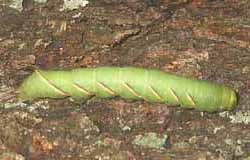 |
Sphinx luscitiosa WO, Canadian Sphinx; Clemen's Sphinx:
Larval hosts are willow (Salix), poplar (Populus), birch (Betula), apple (Malus), ash (Fraxinus), waxmyrtle
(Morella), and northern bayberry. generally more easterly |
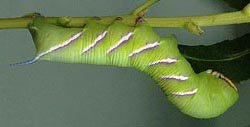 |
Sphinx perelegans
WO, Elegant Sphinx: Unique feature is shield on first thoracic segment, which is same colour as body, forming
tight-fitting hood over vertex of head. This hides a pair of glossy black spots on top of head, which are revealed if animal is disturbed.
|
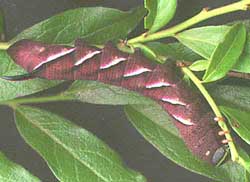 |
Sphinx poecila WO??, Poecila Sphinx:
If you have blueberries in the woods, then you might have the Poecila Sphinx. The green form is more common.
|
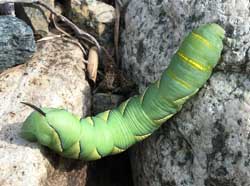 |
Sphinx vashti WO, Snowberry Sphinx: Larvae feed on the common snowberry (Symphoricarpos albus)
and on coralberry (S. orbiculatus). Note the two golden lines of slightly raised bumps, one just behind the head, the other on the thorax. |
Smerinthini Tribe:
 |
Pachysphinx modesta WO, Modest Sphinx; Poplar Sphinx:
Larvae feed on poplars and cottonwood. The anal horn is greatly reduced in the final instar. |
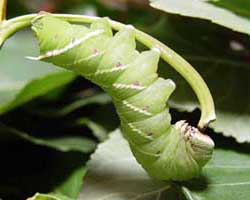 |
Pachysphinx occidentalis WO, Big Poplar Sphinx:
Larvae feed on cottonwood and poplar (Populus) and willow (Salix).
Larvae are very chunky with little to distinguish them from Pachysphinx modesta. (generally more southerly)
|
 |
Paonias excaecata WO, Blinded Sphinx:
Larvae accept willows, birches, and cherries. I have also found them in the wild on oak in eastern Canada.
Skin is quite granulous. |
 |
Paonias myops WO, Small-eyed Sphinx:
Wild cherry species are the favorites as larval foodplants, but eggs will also be deposited on birches and other forest trees.
There are varying degrees in the amount of red markings along the sides. |
 |
Smerinthus cerisyi WO, Cerisy's Sphinx;
Greatly resemble modesta larvae, pale green, granular skin, pale lateral diagonal lines, faint red
spiracular circles, very pale longitudinal lines running from head to more pronounced anal diagonal line.
Green heads bounded dorsally with a pale yellow inverted "V".
|
 |
Smerinthus jamaicensis WO, Twin-spotted Sphinx:
Larvae feed upon many forest trees including birches and cherries, but are expecially fond of poplars and willows. Red markings on sides
vary greatly from specimen to specimen. |
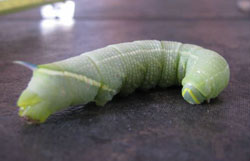 |
Smerinthus ophthalmica WO: Resemble cerisyi larvae, pale
green, granular skin, pale lateral diagonal lines, faint red
spiracular circles, very pale longitudinal lines running from
head to more pronounced anal diagonal line. Larvae have green heads bounded dorsally with pale yellow
inverted "V". Note blue horn.
|
Macroglossinae subfamily
Dilophonotini tribe:
 |
Hemaris diffinis
USGS???,
Snowberry Clearwing; Bumblebee Moth:
Snowberry (Symphoricarpos),
honeysuckle (Lonicera), Coralberry, viburnums, Blue Dogbane
(Apocynum), dwarf bush honeysuckle (Diervilla lonicera).
Horn black; yellow base. (generally east of Continental Divide)
|
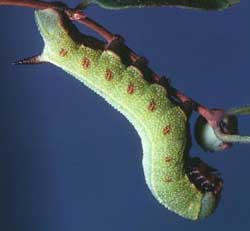 |
Hemaris thetis WO:
Larval host plants include Snowberry (Symphoricarpos), honeysuckle (Lonicera), Coralberry, viburnums, high bush cranberry and hawthorn
(Crataegus). Horn black with slightly lighter base. western species was formerly classified as
H. diffinis or H. senta. Those species west of the Continental Divide are now classified as H. thetis.
|
Macroglossini tribe:
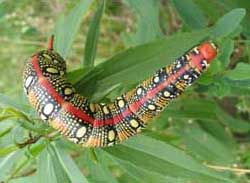 |
Hyles euphorbiae
??, Leafy Spurge Hawk Moth Larvae feed on leafy spurge. Larvae are also conspicuously colored, with a
pronounced tail or "horn" near rear end. Young larvae are variously patterned with green, yellow, and black;
older larvae have distinctive red, black, yellow, and white color pattern. Mature larvae may approach 10 cm in length; when disturbed,
they regurgitate a slimy green liquid. |
 |
Hyles gallii
WO, Bedstraw Hawk Moth or Gallium Sphinx:
This species is not reported in Chippewa, but it has been recorded in
eastern Wisconsin counties. I suspect it is present.
Larvae come in black and in brown forms and often feed on
Epilobium (fireweed).
|
 |
Hyles lineata
BAMONA, the White-lined Sphinx
Larvae are highly varied and feed on a great diversity of plants
including willow weed (Epilobium), four o'clock (Mirabilis),
apple (Malus), evening primrose (Oenothera), elm
(Ulmus), grape (Vitis), tomato (Lycopersicon),
purslane (Portulaca), and Fuschia.
All larvae seem, however, to have the red/black swellings split by
dorso-lateral lines.
|
|
